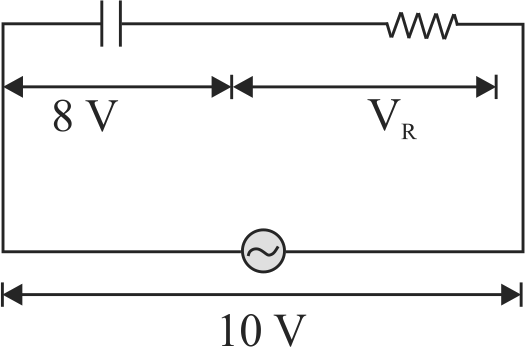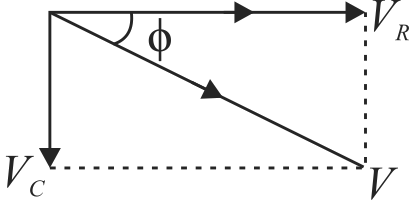355990
The diagram shows a capacitor \(C\) and a resistor \(R\) connected in series to an ac source. \(V_{1}\) and \(V_{2}\) are voltmeters and \(A\) is an ammeter
Consider the fallowing statements
I.
Reading in \(A\) and \({V_2}\) are always in phase.
II.
Reading \({V_1}\) is ahead in phase with reading in \({V_2}\).
III.
Reading in \(A\) and \({V_1}\) are always in phase.
Which of these statements are/is correct.
355990
The diagram shows a capacitor \(C\) and a resistor \(R\) connected in series to an ac source. \(V_{1}\) and \(V_{2}\) are voltmeters and \(A\) is an ammeter
Consider the fallowing statements
I.
Reading in \(A\) and \({V_2}\) are always in phase.
II.
Reading \({V_1}\) is ahead in phase with reading in \({V_2}\).
III.
Reading in \(A\) and \({V_1}\) are always in phase.
Which of these statements are/is correct.
355990
The diagram shows a capacitor \(C\) and a resistor \(R\) connected in series to an ac source. \(V_{1}\) and \(V_{2}\) are voltmeters and \(A\) is an ammeter
Consider the fallowing statements
I.
Reading in \(A\) and \({V_2}\) are always in phase.
II.
Reading \({V_1}\) is ahead in phase with reading in \({V_2}\).
III.
Reading in \(A\) and \({V_1}\) are always in phase.
Which of these statements are/is correct.
355990
The diagram shows a capacitor \(C\) and a resistor \(R\) connected in series to an ac source. \(V_{1}\) and \(V_{2}\) are voltmeters and \(A\) is an ammeter
Consider the fallowing statements
I.
Reading in \(A\) and \({V_2}\) are always in phase.
II.
Reading \({V_1}\) is ahead in phase with reading in \({V_2}\).
III.
Reading in \(A\) and \({V_1}\) are always in phase.
Which of these statements are/is correct.
355990
The diagram shows a capacitor \(C\) and a resistor \(R\) connected in series to an ac source. \(V_{1}\) and \(V_{2}\) are voltmeters and \(A\) is an ammeter
Consider the fallowing statements
I.
Reading in \(A\) and \({V_2}\) are always in phase.
II.
Reading \({V_1}\) is ahead in phase with reading in \({V_2}\).
III.
Reading in \(A\) and \({V_1}\) are always in phase.
Which of these statements are/is correct.


